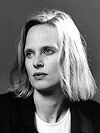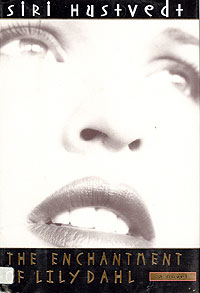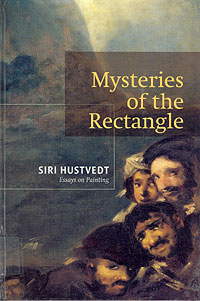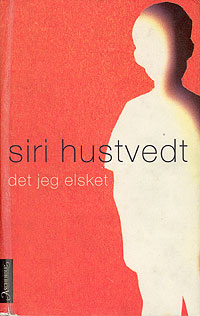| |
SØK | |||
| Om biblioteket | ||||
| Tema | Musikk | Litteratur | ||
| Utstilling | Edvard Grieg arkiv | Kunst og kultur | ||
| Lesetips | Lokalhistorie | Vestlandsforfattere | ||
| Prosjekt | For barn | Ut i verden | ||
Siri Hustvedt
| Interview by Mirjam Kristensen
|
 |
When you published your first novel, The
Blindfold, you had already published a book of poetry. What made
you leave the poetry and enter the novel?
I wrote poetry all through high school, during my year in gymnasium in
Bergen, through college, and into my years as a graduate student at Columbia
University. I always hoped to be able to write a novel, but didn’t
understand how to do it, and I loved poetry. A moment came in graduate
school when I got stuck. I had already published a poem I liked in The
Paris Review, but somehow everything I was writing after that was
very stilted and bad. A professor of mine, David Shapiro, who is also
a wonderful poet, recommended that I do automatic writing like the Surrealists
just to loosen myself up. I followed his advice and wrote thirty pages
of prose in a sitting. I liked what came out. The next three months were
spent editing those pages, which became a prose poem called “Squares.”
I never wrote anything in lines again. I seemed to have found a form for
myself.
Will you ever leave the novel, and say,
write essays instead?
No, I don’t think so. I love writing fiction, but I’ve come
to realize that I can’t move quickly from one novel to the next
the way many writers can. A novel takes a long time to gestate inside
me, and between books, I’ve discovered the immense pleasure of writing
essays. The form, which is infinitely elastic, has provided me with a
way of searching for answers to ultimate questions, which usually go unanswered,
but which give me a chance to flex my thoughts. Nevertheless, the difference
between fiction and non-fiction has become more opaque as I get older.
What separates the two now is simply this: When I write an essay I am
adopting my own “I”. When I write fiction, I am taking on
another voice, but even this is complex because I know that my “own
first person” isn’t univocal but plural as well. Essayer
“to try”—I am always aware of its meaning when I write,
and I never know what will come of the attempt.
Both The Blindfold and The
Enchantment of Lily Dahl open with a situation where the main character,
both young women, sits in hiding in their houses and watch another person
in a building across the street. What is it with this situation that fascinates
you so much?
This fact has been pointed out to me several times, and it may surprise
you to know that I was completely unaware of it. However, now that I know
I started two novels with similar scenes of spying, I can speculate on
the reasons why. Art of many kinds is a form of voyeurism. The writer
and the visual artist both remain outside the story being told or the
image that is being made, and I think this idea of the observer haunts
my work. Even in my last novel, Leo Hertzberg, the narrator, is a kind
of specialized spectator, an art historian. There is an erotic dimension
to spying as well.
Both Iris and Lily are alone and longing for a future that includes physical love and their voyeurism, looking at the bodies of strange men, is part of their hopes for what might come. Leo, too, after his life changes, feels isolated and longs for love. He becomes a lone man watching the stories of others unfold. This isn’t so different from being a novelist, making up a story for others and discovering what happens along the way.
And the erotic is also important in all
your novels?
It’s important to life, and that means it will turn up in all my
books as a force. The erotic begins in life before language, in our early
physical relationship with our mothers, and I think it’s very hard
to talk about it without falling into clichés, which makes it challenging
to describe in a novel. Eroticism is quite separate from friendship although
they may overlap, and it’s forms are often given in the culture.
I am very interested in the cultural and biological thresholds between
men and women, how they work and what they mean. We are all made of both
men and women, after all, and I think there’s a sliding scale of
sexual identification, created through both genetic and cultural realities
that make what we think are obvious differences far more blurry. I am
deeply aware of myself as a woman who also identifies with men, and in
the novel, I’ve found an outlet for both femininity and masculinity
and its erotic expressions in my characters.
I once read an interview with you were you
told about the use of your own biography in your novels, like the anagram
of your own name (Iris=Siri) in The Blindfold. What is the relationship
between facts and fiction, your own life and the invented one, in your
novels?
I have thought long and hard about autobiography and fiction, but I still
have no single or clear answer. I do know that during the writing of each
of my books, I am always trying very hard to make something that is
emotionally true for me, that is, I’m creating a fiction that
answers some profound need in myself. There is always an autobiographical
seed, a beginning that reverberates with my life, a feeling, an image,
a little story, but the narrative itself inevitably diverges from actual
events. I think this is rather like dreaming. Dreaming is often a deeply
emotional experience, even though what occurs in the dream itself may
not resemble waking life. I often don’t understand what I’m
doing when I write. Something happens, and it surprises me, but it feels
right, feels true, and I trust it. In some way, I think my books are alternative
autobiographies, ways of reinventing experience from other points of view,
distorted mirrors of what I’ve lived or might have lived, had I
been less stable like Iris, had I been tougher like Lily, had I been a
man and a Jew, like Leo or a visual artist like Bill… All my characters
partake of me, and yet they are imaginative constructions that somehow
take on lives of their own.
In Yonder you write openly and
almost nakedly about your life and your family life. Is the use of biographical
stories different in essay writing?
This is a great question. Yes, biography is different in the essay. My
feeling is that in a work of nonfiction, there is a contract between the
writer and the reader that the work is the true. By true, I mean simply
that at no point is the writer consciously saying anything he or she knows
to be false. It is not allowed to embellish a story with an invented conversation,
for example, even if it is close or similar to the actual
exchange, if you don’t remember it, word for word, which nobody
does, except perhaps mneumonists. If my memory has become foggy, it is
my duty to tell the recollection as I see it in my mind, not as I would
like it to be. The novel is also about truth telling, but in a different
way. It’s about seeking emotional truths, many of which may appear
suddenly and unconsciously. When it happens, I trust my gut and feel that
somehow this sentence has come close to a true thing, but there is no
a priori restriction on my invention. 
Your word “naked” interests me, too. I have a book of essays coming out in January of 2006, and my editor selected several passages as possible quotes to appear on the back cover. As I read over them, I thought, “Good heavens, you can’t put that on the outside of a book!” This experience amused me because I realized that some of those passages were simply too naked. They had to stay inside under wraps. When I choose to tell something about myself, I would feel wrong unless I told it as honestly as I possibly can. That kind of honesty can have a tough, stripped quality to it, even for me after I’ve written it. I pride myself on that nakedness, however, and have no desire to change it. At the same time, I’m not interested in confession for the sake of confession. In fact, the literature of telling all annoys me. The person who deposits on the page a sordid story, simply because he or she feels the need to dump it on a morbidly curious reader, doesn’t interest me at all. On the other hand, if you think of the great confessions (St. Augustine and Rousseau leap to mind), you understand that these stories, some of them brutally honest and frankly embarrassing, are told in the service of a much larger human question.
Your novels are full of references to art
and the making of art. The project where Iris in The Blindfold
has to study a little dot of dust day after day, seems to be some kind
of art project. In What I loved one of the main characters, Bill,
is an artist and his works and the works of others are described. What
kind of function does art have in a novel? Can a work of art be so perfectly
described in a novel that it would be disappointing to really see it?
Do we see art differently through a novel?
I’ve always been fascinated by visual art. As a child, I was drawing
constantly, and I still like to draw and love to look at painting, sculpture,
and installations. I’ve also been writing about art for the last
ten years and have just published a book on painting called Mysteries
of the Rectangle. You’re absolutely right, however, that verbal
descriptions of a work of art are very different from seeing the piece
in front of you. An image and words on the page are essentially different,
although they work together. Most images are delineated through language,
that is, the word chair serves as an isolating concept that allows
us to separate chair from floor, for example. People
who are blind from birth and have their sight restored are often unable
to see objects as distinct because their brains didn’t develop through
language and sight, but through language and hearing, touch, taste, and
smell. When I read novels, on the other hand, I always see the action
in pictures. I give myself an adequate image that will take me forward
in my reading, and I usually remember the fiction I’ve read through
those pictures, not words, despite the fact that the words generated the
images. This is very complicated and has to do with the different parts
of brain (right and left) involved with generating whole object representations.
That said, when I describe a work of art in words, I’m simply describing
a picture I’m seeing in my head, whether it’s the peculiar
contents of Mr. Morning’s boxes, Ed’s narrative paintings,
or Bill’s various works over time. What words can do, is give the
reader an insight into the described image that includes the feelings
of the particular spectator. Let us say, you and I look at the same artwork.
It’s possible that you could find yourself terribly moved by it,
and I would be left cold. Your description of that piece would inevitably
be very different from mine. Even when a verbal rendering of a painting,
for example, appears to be highly objective, the word choice will be vital
to what the reader sees in his mind. Of course, to make it even more complicated,
every reader invents his own picture from the text he or she reads. I
doubt that any two readers see exactly the same image.
But you also use art as a device in your
novels?
Yes, although device is maybe the wrong word. I think art in a novel can
be as strong as a character because it occupies an interesting zone between
the personal and the public. As such, a work of art can reveal something
about the person who makes it that the creator may not even know and certainly
can’t articulate. George, the photographer in The Blindfold,
Ed, the artist in The Enchantment of Lily Dahl, and Bill in What
I Loved are all revealed in one way or another through their work.
At the same time, the work is detached from them and becomes part of the
others who look at it. Their inner life appears in translation, as it
were, in the myriad languages of the viewers.
The city, New York City in your case, seems
to be important in your work. The city was already important for writers
like Virginia Woolf, and in Norwegian, Sigrid Undset. Where do you find
yourself in this tradition?
Ah yes, the city. I was born in a little town, so my move to New York
City was a great shift for me. The city, more than a little town, is like
a literary character in itself. Small towns are to some degree a collection
of known individuals who together create an atmosphere. One of the extra-personal
qualities of small towns that interests me is gossip. I used this in The
Enchantment of Lily Dahl as a binding element because gossip seems
to have no single origin. It floats. In a huge city like New York, there
are too many people, too many languages, too much anonymity and in general
too much flux for all of it to be perceived by any one person. A great
city is simply too much for human understanding. This means that we take
it in as a jangling, complex, unknowable entity, a many-headed dragon
that’s breathing fire and leaping about and is so large that if
you see it’s mouth, its tail is hidden from you. Virginia Woolf
and Sigrid Undset had their takes on the city, as did Balzac, or my beloved
Dickens, whose view is not unlike mine (an inexplicable thing). His genius
in describing his own city, London, however, is probably unparalleled
in literature.
You have many readers, your novels
are being translated and you probably get a lot of attention from the
media. How do you find the quiet and secret room to sit down and write
now? Is it different from before you were known to many?
I’ve been very glad that my books have been translated and that
I have more readers now than I’ve ever had before. This is gratifying.
I suspect that every writer wants to be read. I get more requests now
to write this or that or read here and there. Literary business takes
up more of my time than it used to, but I would rather have these extra
distractions than feel ignored. At the same time, my inner life when I’m
writing is the same. It is still hard for me to figure out what the heck
I’m doing. I still struggle and suffer and then feel joy when I
seem to have hit the right tone or found the next turn in the story. I
still feel the need to write and work hard at it. Because I’m now
the mother of an eighteen-year-old daughter on the verge of leaving her
parents for college, I actually have more time than I’ve ever had
for just writing. It isn’t just a matter of hours in the day either.
It has to do with a greater emotional room and space that comes from having
an independent, near grown-up as a child. Of course, I’ll always
be Sophie’s mother just as my mother remains an essential person
in my life, but my life has changed, and I’ve discovered that as
much as I loved being the mother of an infant and then a child, I like
this moment, too, and am enjoying the greater freedom it has given me.
The Books
Reading to you (1981)
The Blindfold (1992)
The Enchantment of Lily Dahl (1996)
Yonder (1998)
What I loved (2003)
Mysteries of the Rectangle (2005)
A Plea for Eros (2006)
Written by Mirjam Kristensen, Galleri
©Bergen off. bibliotek
|
Forfattere fra andre land |
| Tema | Musikk | Litteratur | Søk |
| Utstilling | Kunst og kultur | MappaMi | |
| Lesetips | Lokalhistorie | Ut i verden | Kikkhullet |
| Prosjekt | For barn | Vestlandsforfattere | Om biblioteket |

